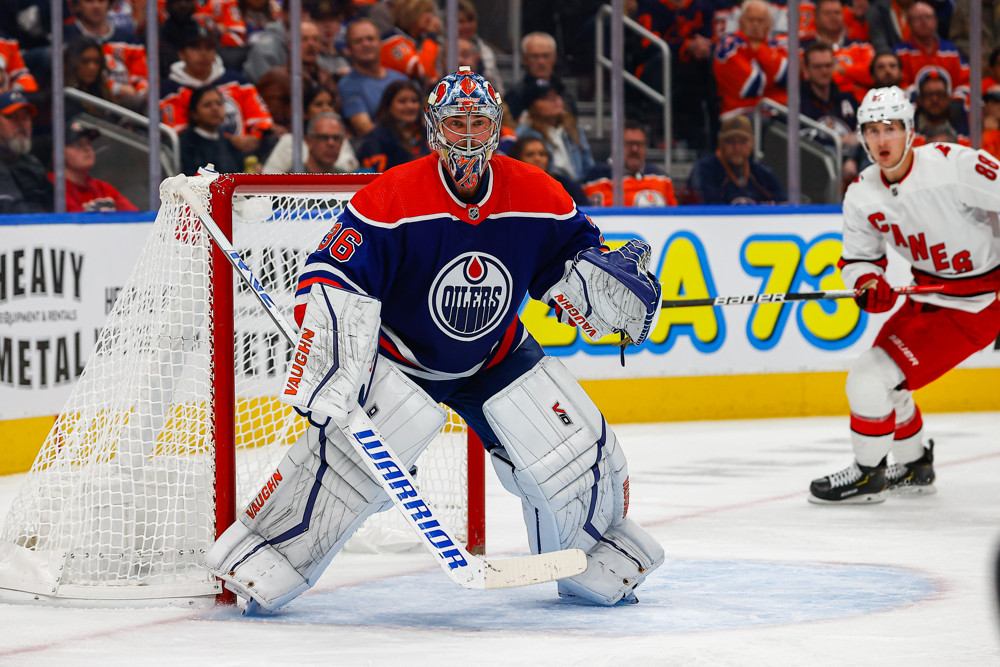
A bittersweet opening weekend for Edmonton Oil Kings
September 29, 2023
Jack Campbell Shines as Oilers Edge Flames in OT
September 30, 2023September 29, 2023 by Ryan Lotsberg
Evander Kane hinted at their being changes in the neutral zone and defensive zone strategies for the Edmonton Oilers this yearwhile speaking with the media on September 20. Ryan Rishaug told us about the 1-1-3 system being used in the neutral zone which was implemented on day one of training camp. Bruce Curlock (@bcurlock) from OilersNation did a great piece on the new defensive zone strategy that head coach Jay Woodcroft will be using this season after Wednesday’s victory over the Vancouver Canucks.
The Oilers will be shifting from a man-to-man defence to a zone defence. Teams were able to victimize the Oilers by getting the defencemen to chase their marks high in their own zone, leaving forwards to defend down low and in the slot, which is out of their comfort zone. The Vegas Golden Knights did a great job of causing chaos in the Oilers zone during their second round series last season, which is the biggest reason that they won the series. The Oilers defencemen were more disciplined in not chasing their marks up to the blue line in the second half of last season, and the defensive results improved as a result.
Curlock broke down the new zone defence structure wonderfully, but the system is a box plus one. One player pursues the puck aggressively while the other four form a box to protect the slot area. The result is fewer opportunities from premium scoring areas. The group will also be closer together when pucks are turned over, which will lead to more outlet options. Those passing options will be shorter passing options. Shorter passes have a higher completion rate than longer passes. This should result in the Oilers exiting their zone with possession more often, and it should lead to plenty of rush opportunities, an area where the Oilers excel.
Related: Woodcroft Implements 1-1-3 Neutral Zone System
“[in the] D zone specifically, Were working on protecting the important parts of the ice and that might mean that we spend more time in the defensive zone because we’re holding our zones and our lanes and our positions a little more, but those longer lengths of time in our zone will be theoretically hypothetically to the outside, to the perimeter” said Derek Ryan on Oilers Now on Thursday. “I think we just want to limit those mistakes that result in grade As because in a zone coverage you have layers of protection there.”
Ryan referenced the Jonathan Marchessault goal in game six against the Oilers last spring where he was all alone in the slot for a tap-in goal. I saw two goals from Marchessault that could fit that description in that game. He said that goals like that won’t happen with this type of zone defence being utilized. Bob Stuaffer also noted that Vegas played a zone defence last year, to which Ryan added that came from Golden Knights head coach Bruce Cassidy. Cassidy employed a zone defence with the Boston Bruins as well.
The need to address team defence is priority number one this season, and Woodcroft implementing these new neutral zone and defensive zone systems is a sign that he is taking the challenge to heart. The 1-1-3 neutral zone system will reduce the number of odd man rushes allowed, which was a problem last year. Turnovers, bad pinches, and bad changes are going to happen; but the 1-1-3 will help. The defensive zone system puts a premium on the slot area. The chances allowed by the Oilers need to be of lower quality, and this system addresses that.
These systems are approximately the most passive defensive systems out there, which means that turnovers are designed to be created closer to their own net than the opposition’s net. That’s okay in my opinion because the Oilers are so good off the rush. We know what Connor McDavid can do on the rush. Leon Draisaitl is dangerous off the rush too. Ryan McLeod carries the puck through the neutral zone with a ton of speed. “Passive” sounds boring, but this team could use a little bit of “boring” in their game. That’s what it takes to win close hockey games. They need to be able to put the clamps down late when defending a lead, and these systemic changes should help that cause.


